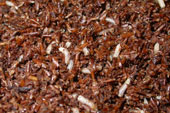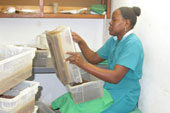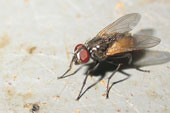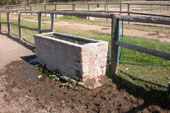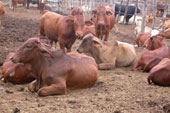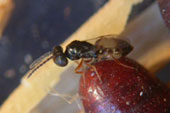 |
| Home |
| Products |
| PER-MX® |
| RAP-TX® |
| TRI-MX® |
| Citrus Pests & diseases PHoto Gallery |
| Packaging / Shipping |
| Contact Us |
| Enquiries |
 |
| Raptor Fly Parasites |
|
RAP-TX – (Muscidiferax raptor)
Target organisms / uses Advantages of using Raptor parasites / biological control Timing - where and when to use Raptor parasites Biology of Raptor parasites Questions and answers 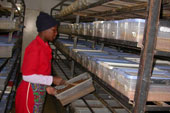 Numerous diet containers are daily prepared to ensure a constant supply of quality Raptor parasites. To many people, the word “parasite” conjures up negative images of worms and organisms that live off humans or animals, for instance ticks, tape worms or bilharzia. There is, however, beneficial insect parasites, such as Raptor parasitic wasps, which play a vital role in the control of some of the most common nuisance pests, e.g., the common house fly. Raptor parasites are tiny, nocturnal wasps (Order: Hymenoptera), and though lethal to flies, are completely harmless to humans. We breed these wasps in temperature-controlled rooms in our insectary, on the outskirts of Tzaneen, using their natural hosts (fly pupae and larvae), which we breed on a mixture of bran and milk powder. We’ve been a leading supplier of fly parasites to South African beef, diary and equestrian estates for the past five years through our relationship with Biofly, a Western Cape biocontrol company. Target organisms / uses: Raptor parasites are capable of controlling the house fly (Musca domestica), but they also attack various kinds of other flies (e.g. stable flies, latrine flies and the lesser house fly). They also attack fruit and pumpkin flies, though to a lesser extent, and thus their use against aforementioned species is not encouraged. Fly parasites can be used virtually anywhere (both indoor and outdoor), where a suitable substrate is available to flies for breeding. Flies prefer to lay their eggs in damp or moist organic matter (about 60% moisture content), and thus all such sources should be regularly treated with fly parasites, to curb infestations. Advantages of using Raptor parasites / biological control
Raptor parasites can be used where-ever flies are present and found to breed. Preferred habitats of fly maggots are trash cans, manure piles, outside toilets (pits / long drops), dairies, stables, feedlots, fowl runs, chicken batteries, compost heaps and manure piles. Thus all these areas are prime target areas to use Raptor parasites. Spring / early summer is the best time to use the Raptors to control flies, especially after the first rains in the summer rainfall area. They can be used in conjunction with certain chemical methods of fly control. Contact us for free advice on the optimal integration of chemical, cultural and biological control methods. If you’re off to a late start, it will still be possible to get your fly problem under control, though it will probably take a bit more effort and time to see results. Our trained sales consultants will be able to offer a tailor-made recommendation based on your expectations and specific needs. Mode of action: Raptor parasites control house flies by parasitisingDefinition of ‘Parasite’ or Parasitise: According to Price (1997) a parasite (or parasitoid as it has been called since the 1960’s) can be defined as an insect that requires and eats only one animal (insect) in its lifetime, but may ultimately be responsible for killing many. For example, a female wasp lays an egg on a host (or prey), the larva hatches and consumes the host, becoming a free-living adult which may proceed to other hosts to lay her eggs (or parasitise). Source: Price, P.W. 1997. Insect ecology. 3rd Edition. John Wiley & Sons Inc. and mutilating fly larvae (maggots) and pupae, thereby interfering with the normal lifecycle of flies as they develop from larvae (maggots) to pupae to adults. Biology of Raptor parasites: Raptor parasites belong to the family Pteromalidae. Raptor parasites occur indigenously in Africa, but are commercially reared and available in Europe, Central and North America. They are tiny little wasps (1 – 2 mm in length), nocturnal and are antlike as they prefer to walk rather than to fly. They do not have a sting like bees and are completely harmless to humans and animals. They are hardy and are not too much affected by weather. Life cycle Raptors mainly parasitise young fly pupae. The female wasp deposits a single egg into the fly pupae’s body fluid. The Raptor larvae develop in the body fluid as the fly is pupating, and completes its lifecycle within the fly pupa (turning from larvae to pupa to adult wasp) during the following two to three weeks. Thus, a mature Raptor wasp emerges from the fly pupa, instead of an adult fly. A female Raptor can parasitise in excess of 50 fly pupae in her life time. 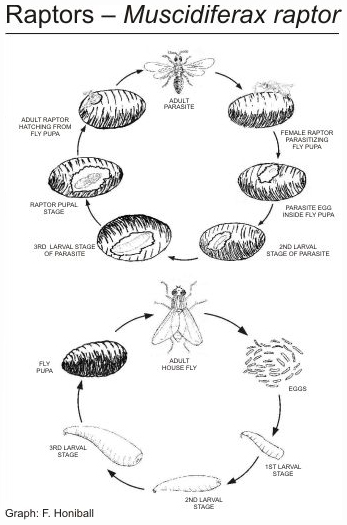 Orders / dispatching of Raptors: (How to get started) 1. Decide on a release programme (i.e. quantities and timing of releases) in conjunction with your local sales representative or Online sales consultant. 2. You may place your written order by mailing or faxing your order form. Your order will be acknowledged / confirmed by our Production Department within 5 working days of receipt thereof. 3. The Raptor parasites are packaged and dispatched according to specification in polystyrene cooler boxes – 5000 per plastic bag (a ‘colony’). 4. The client receives a notification mail / SMS informing him / her of the tracking no. of the parcel, specifying the expected date of arrival. 5. As soon as the parcel is received / collected from the Post Office, we recommend that the parcel be opened and the wasps distributed according to the enclosed recommendations. Other practices which may contribute to successful fly control: To include effective micro – organisms (EM) in the production of compost on the farm. Although there is uncertainty on the mechanism involved, researchers at the University of Stellenbosch found that dung heaps treated with EM’s, had a significantly higher Raptor parasitism rate compared to the non-treated ones. Questions and answers: How effective are they? Once the flies are under control, can the parasites switch to something new / become a pest themselves? Can fly parasites be integrated with other present remedies / practices? How are they released? Do the parasites survive in nature? How about poison and traps, can / should one stop using them? It is very hot here; will the parasites be successful? I am a house wife from Bellville. Can fly parasites reduce fly numbers in and around my house? How effective are they? This parasite occurs in nature where the ecosystem is in balance (where humans have not taxed the ecosystem and caused imbalances by excess waste production and intensive farming methods etc.). In nature the percentage of parasitisation of flies is around 10 – 20 %. However, when additional Raptors are released into an area the parasitisation can increase up to 90%. A single female fly can lay between 600 and 900 eggs. A single female Raptor can only parasitize about 50 fly pupae. The best strategy to manage flies is thus to use a combination of control methods that are aimed at different life stages of flies. Optimally integrating available control measures and applying the principles contained in this guideline should lead to a marked reduction of nuisance flies in most agri-ecosystems and production plants. Once the flies are under control, can the parasites switch to something new / become a pest themselves? No, they are very specific in their food preferences, and would rather die or disperse than utilize an unknown host. That is the reason why Raptor wasp parasites are recommended and used by entomologists and pest control practioners worldwide Can fly parasites be integrated with other present remedies / practices? Yes, certainly. The (adult) flies which are normally causing disturbance for man and animal are often only the tip of the iceberg (they constitute about 18% of the total population). The majority of flies are often “on their way”, busy transforming from their different life stages (e.g. eggs to maggots, to pupae, to adults). Considering the fact that parasites do not attack adult flies, it is recommended that some of the following control methods be integrated into your fly control program: sticky tapes, light traps, bait traps or insecticides (applied to walls). We do not encourage the use of (surface) insecticides on organic matter, because it will destroy most of the organisms involved in the biological control of flies. How are they released? Parasitized fly pupae are packed in numbers of 5 000 per perforated plastic bag. The pupae should be released as close as possible to the breeding areas of the flies. Any wet / moist areas, where urine is released or water leakages occur (e.g. water pipes), manure and compost heaps, are ideal fly breeding areas, and therefore ideal release areas. The plastic bags can be opened and the content distributed on the obvious release points. More detailed information will be supplied with the first consignment. Do the parasites survive in nature? Yes, provided that climatic conditions are favourable and sufficient food (fly larvae/pupae) is available, they can survive for approximately for 14 days. Extremely cold or dry winter conditions normally reduce fly numbers and may also lead to a reduction in the Raptor parasite population. How about poison and traps, can / should one stop using them? It is often advisable to initially continue with bait applications or baited traps to augment biological control measures, since the wasps don’t attack adult flies. After a month or two, the number of traps may be gradually decreased as the biocontrol effort start taking effect. In our view commercial farmers should try to avoid contact (broad spectrum) insecticides applied on the surface of compost or dung heaps. Systemic insecticides (e.g. animal feeds containing insect growth regulators) is in our view also not compatible with augmentative insect releases since they tend to disrupt the biocontrol effort. It is very hot here; will the parasites be successful? Where ever flies survive, the Raptors are also able to survive. Flies normally prefer shady, moist areas to lay their eggs, and the Raptors will thus search out these areas in search of prey. I am a house wife from Bellville. Can fly parasites reduce fly numbers in and around my house? Yes definitely, provided you are able to seek and find suitable fly breeding spots outside and around your house e.g. dustbins (where nappies may accumulate), compost heaps or dog pooh disposal areas. Bear in mind that your neighbours’ compost heap (or a nearby municipal waste disposal site) may actually be to blame for your fly problem, hence you may wish to introduce them to the benefits of Vital Bugs’ biocontrol solutions. |

© Copyright Vital Bugs 2008 | All Rights Reserved
